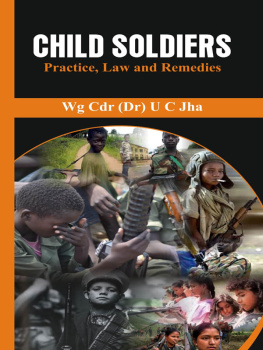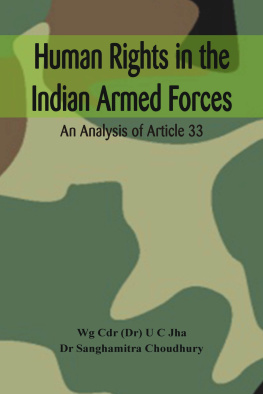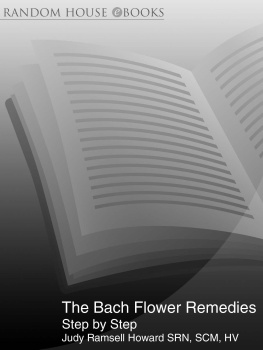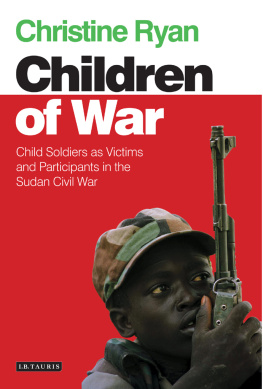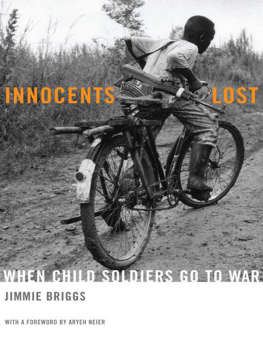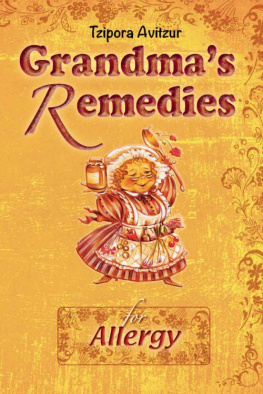Published by
Vij Books India Pvt Ltd
(Publishers, Distributors & Importers)
2/19, Ansari Road
Delhi 110 002
Phones: 91-11-43596460, 91-11-47340674
Fax: 91-11-47340674
e-mail:
Copyright 2018, Wg Cdr (Dr) U C Jha
ISBN: 978-93-86457-52-3 (Hardback)
ISBN: 978-93-86457-54-7 (ebook)
All rights reserved.
No part of this book may be reproduced, stored in a retrieval system, transmitted or utilised in any form or by any means, electronic, mechanical, photocopying, recording or otherwise, without the prior permission of the copyright owner. Application for such permission should be addressed to the publisher.

I n every society down the ages, children have been held as mans most precious resource and the most important national asset. The future of a nation hinges on the health and all round development of its children. Since children are the weakest and most vulnerable section of society, it is the duty of the society to protect them from exploitation of all forms and ensure their development in a healthy environment. Unfortunately, the ongoing armed conflicts in many regions of the world, coupled with acute poverty, discrimination, exploitation, corruption, and lack of education, health and social welfare has resulted in grave violations of the rights of children. A large number of non-state armed groups (NSAGs) have recruited children to perform various tasks during armed conflicts. Irrespective of the roles they perform, child soldiers are exposed to acute levels of violence as witnesses, direct victims and as forced participants. Some are injured and have to live with disabilities for the rest of their lives.
The use and recruitment of children as soldiers is not a phenomenon restricted to a particular region, conflict situation or continent. It is a global issue that demands a measured global response. There are approximately 300,000-350,000 child soldiers worldwide. Most of them are victims of illegal recruitment practices. They work as combatants, spies, cooks, porters, messengers and also as sex slaves for adult soldiers. They are increasingly being used as human shields, for carrying out acts of terror, including as suicide bombers, and even as executioners by NSAGs. Besides, several countries still recruit individuals below 18 in their armed forces under the pretext that they would be undergoing military training and would not be deployed until attaining the age of 18. For instance, the British armed forces recruited 2,250 children (under the age of 18) in the financial year 2015-16. Researchers have established that children in the age group of 16-17 are emotionally underdeveloped and should not be put through military training, which conditions them psychologically to obey all orders without question, including the order to kill. The Indian armed forces also recruit persons below 18 years of age.
In spite of the many international treaties, agreements and conventions on safeguarding children, child soldiers are extensively used in many parts of the world. The international community views the abuse of children as a tragedy, but has failed to put an end to this practice. The UN Committee on the Rights of the Child, in its concluding observations published in July 2016, expressed grave concern that in Pakistan, children continue to be targeted for recruitment and training by armed groups for military activities, including suicide bombing and the detonation of landmines, and that they are transferred to the frontlines of conflict areas where they are exposed to mortal danger, and that the State party has taken insufficient measures to prevent such recruitment.
The UN Secretary-Generals annual report on children in armed conflict lists the States and non-state actors responsible for the recruitment and use of child soldiers. In the past two years, civil society organizations and the media have exposed the undue pressure (including threats to withdraw funding) exerted on the UN by some Member States to avoid being listed, despite credible evidence pointing to violations. In 2015, then UN Secretary-General Ban Ki-moon succumbed to pressure from the US to prevent the listing of the Israeli Defence Forces, in spite of a recommendation from his Special Representative to do so. In 2016, the Secretary-General faced pressure from Saudi Arabia, to remove the Saudi-led coalition from his list. The coalition forces had been listed for the grave violations of killing and maiming of children and attacks against schools and hospitals in Yemen.
This book about child soldiers contains six chapters. Chapter I gives a historical account of the use of children in war, defines the term child soldier, describes the modes of recruitment of children and seeks to find an answer as to why recruiters prefer children. The Second chapter deals with the recruitment and use of child soldiers in 14 countries, namely Afghanistan, the Central African Republic, Colombia, the Democratic Republic of Congo, India, Iraq, Myanmar, Nigeria, Pakistan, Palestine, Israel, Somalia, South Sudan and Yemen. The UN Security Council has focused on six grave violations against children in current warfare: killing and maiming, sexual violence, recruitment and use, denial of humanitarian access, abduction, and attacks on schools and hospitals. These are discussed in the Third chapter.
).
I am thankful to my wife, Ratna, for her constant support, and to Medha and Chandana for editorial assistance. I would also like to thank Vij Publications Pvt Ltd, New Delhi, for their cooperation in bringing out this volume.
U. C. Jha
I n 1924, the Geneva Declaration on the Rights of the Child enunciated a set of principles aimed at ensuring the well-being and protection of the child. set out an international complaint procedure for child rights violation. The Third Protocol allows children from states that have ratified it to bring complaints directly to the UN Committee on the Rights of the Child if they cannot find a solution at the national level. According to the Office of the United Nations High Commissioner for Human Rights, the ability of children, in their individual capacity, to complain about the violation of their rights in an international arena has brought real meaning to the rights contained in the human rights treaties.
When childrens rights are being incrementally expanded in the international and domestic arenas, one wonders how a child can be exploited as a soldier, used as a human bomb or abused as a victim of human trafficking. Despite the advances in international law, technology, and human rights consciousness, we are witnessing the dreadful abuse of children in armed conflicts globally. These abuses are directly related to the denigration of the respect for international humanitarian and human rights law by parties to conflicts. There have been most disturbing reports of sexual exploitation and abuse of children by United Nations peacekeepers and civilians and non-United Nations international forces.
The 2016 Annual Report of the United Nations Special Representative for the Secretary General on Children and Armed Conflict listed nine state armed forces and nearly fifty non-state armed groups (NSAGs) that currently recruit and use children in fifteen countries around the world. The question arises: Who is a child soldier? In laymans language, child soldiers are children under 18 years of age, who are used for military purposes. Some child soldiers are used for fighting theyre forced to take part in armed conflicts, to kill, and commit other acts of violence. Some are forced to act as suicide bombers. Some join voluntarily, driven by poverty, a sense of duty, or the force of circumstance. Some children are used as cooks, porters, messengers, informants, spies or anything their commanders want them to do. Child soldiers are sometimes sexually abused. Whilst some may be in their late teens, others are as young as four years old.




